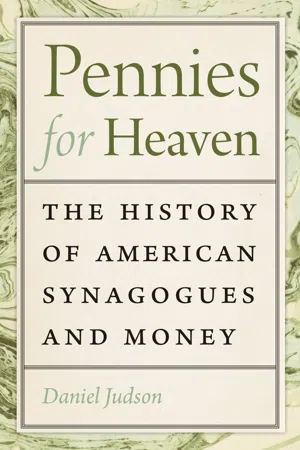![]()
Notes
Introduction
There are of course exceptions to the general rule that synagogue histories ignore economics. For works that do include a significant economic perspective on synagogues, see the following: Hyman Grinstein, The Rise of the Jewish Community of New York (Philadelphia: Jewish Publication Society, 1945); Leon Jick, The Americanization of the Synagogue (Hanover, NH: Brandeis University Press, 1976); Beth Wenger, New York Jews and the Great Depression (New Haven, CT: Yale University Press, 1996); David and Tamar de Sola Pool, An Old Faith in the New World: Portrait of Shearith Israel, 1654–1954 (New York: Columbia University Press, 1955); Frank Adler, Roots in a Moving Stream: The Centennial History of the Congregation B’nai Jehudah of Kansas City, 1870–1970 (Kansas City, MO: Congregation of B’nai Jehudah, 1972); Jonathan Sarna, “Seating and the American Synagogue,” in Belief and Behavior: Essays in the New Religious History, eds. Philip Vandermeer and Robert Swierenga (New Brunswick, NJ: Rutgers University Press, 1991); and Kimmy Caplan, “In God We Trust: Salaries and Income of American Orthodox Rabbis, 1881–1924,” American Jewish History 86 (1998): 77–106.
Jonathan Karp, “It’s the Economy Schmendrick: An ‘Economic Turn’ in Jewish Studies?” AJS Perspectives (Fall 2009): 8–11. Recent books like Rebecca Kobrin’s edited volume, Chosen Capital: The Jewish Encounter with American Capitalism (New Brunswick, NJ: Rutgers University Press, 2012), are explicitly placing economics at the center.
James Hudnut-Beumler, In Pursuit of the Almighty’s Dollar: A History of Money and American Protestantism (Chapel Hill, NC: University of North Carolina Press, 2007), xi.
Moses Weinberger, People Walk on Their Heads, ed. and trans. Jonathan Sarna (New York: Holmes & Meier, 1982), 43.
“President’s Message,” Board Minutes of Congregation Adath Israel, November 18, 1919, AJA.
Leo Franklin, “A New Congregational Policy,” American Israelite, November 17, 1904.
“Temple Israel May Adopt New Pew System,” The Jewish Advocate, February 17, 1921.
On the free synagogue movement, see Melvin Urofsky, A Voice That Spoke for Justice: The Life and Times of Stephen Wise (Albany: SUNY Press, 1982); Stephen Wise, Challenging Years: The Autobiography of Stephen Wise (New York: G.P. Putnam’s Sons, 1949); and Stephen Wise, “What Is a Free Pulpit?” in Free Synagogue Pulpit (New York: Bloch, 1908). On the free church movement, see Garth M. Rossel and Richard A. G. Dupois, eds., The Memoirs of Charles G. Finney (Grand Rapids, MI: Academie Books, 1989), 290–97; Charles C. Cole. “The Free Church Movement in New York City,” New York History 34 (1953): 284–97; and The Congregationalist 77 (December 29, 1892): 219–21. On the relationship of the free church to the free synagogue, see Jonathan Sarna, “Seating and the American Synagogue,” 189–206.
On mushroom synagogues, see Daniel Judson, “A History of Mushroom Synagogues,” American Jewish Archives Journal (forthcoming); Jeffrey Gurock, Orthodox Jews in America (Bloomington: Indiana University Press, 2009), 104–6; Deborah Dash Moore, At Home in America: Second Generation New York Jews (New York: Columbia University Press, 1981), 139–140; and Arthur Goren, New York Jews and the Quest for Community (New York: Columbia University Press, 1970), 76–79.
On the synagogue-center movement, see See David Kaufman, Shul with a Pool: The “Synagogue Center” in American Jewish History (Hanover, NH: Brandeis University Press, 1999), 242–74; and Deborah Dash Moore, “A Synagogue Center Grows in Brooklyn,” in The American Synagogue: A Sanctuary Transformed, ed. Jack Wertheimer (Hanover, NH: Brandeis University Press, 1987), 297–326.
On the hazan craze, see A. R. Malachi, “Hahazanim Harishonim Ba’Amerika,” Hadoar, September 3, 1937 [Hebrew]; Abraham Karp, “An Eastern European Congregation on American Soil: Beth Israel, Rochester, New York, 1874–1886,” in A Bicentennial Festschrift for Jacob Rader Marcus, ed. Bertram Korn (Waltham, MA: American Jewish Historical Society, 1976), 271–72; Mark Slobin, Chosen Voices: The Story of the American Cantorate (Urbana: University of Illinois Press, 1989); and Kimmy Caplan, “In God We Trust.”
For discussion of this term, see Robin Klay and John Lunn, “Protestants and the American Economy in the Postcolonial Period: An Overview,” in God and Mammon: Protestants, Money, and the Market, 1790–1860, ed. Mark Noll (New York: Oxford University Press, 201), 49.
“Minute Book of the Congregation Shearith Israel,” Publications of the American Jewish Historical Society 21 (1913).
Cited in Hudnut-Beumler, In Pursuit of the Almighty’s Dollar, 81.
Hudnut-Beumler, In Pursuit of the Almighty’s Dollar, 94.
Maimonides was a famous dissenter from this position. He took a strident position against rabbis being paid. He warns in his commentary to Pirkei Avot, chapter 4 (Teachings of the Fathers), “Don’t u...


